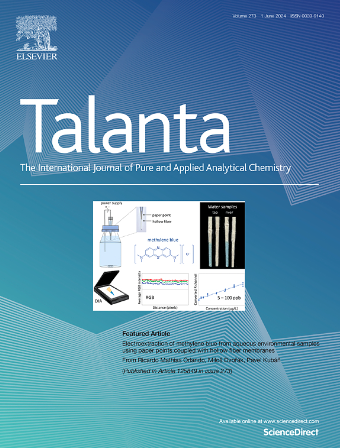Recycling polystyrene and integrating graphite particles: A circular economy strategy for sustainable and enhanced electrochemical sensor manufacturing
IF 6.1
1区 化学
Q1 CHEMISTRY, ANALYTICAL
引用次数: 0
Abstract
The recycling of polystyrene (PS)-based cups for the additive manufacturing of sustainable, cost-effective, and high-performance electrochemical devices is presented here for the first time. In this approach, we integrated graphite (Gpt, a conductive material) within the PS matrix (a thermoplastic component) to design alternative conductive filaments for the production of new electrochemical sensors using a 3D pen (an easy-to-use and transportable tool). Various material ratios were examined, with the Gpt/PS (50:50) composition showing enhanced electrochemical performance without compromising printability. Structural, morphological, and thermal information on the proposed materials was accessed using Raman and infrared spectroscopy, scanning electron microscopy, and thermogravimetric analysis. The electrochemical features of the material were studied by electrochemical impedance spectroscopy and voltammetric measurements using model species such as [Fe(CN)6]3−/4−, hexaminruthenium (III) chloride, and dopamine, highlighting a charge transfer resistance (Rct) value of 1.5 kΩ and an elevated electroactive area of 49.3 mm2 due to the electrical properties offered by Gpt. Additionally, a differential pulse voltammetry based method was developed for sulfanilamide antibiotic detection, a molecule of interest in various fields (pharmaceutical, food, and environmental). Noteworthy linear ranges (1–10 μmol L-1 and 10–50 μmol L1), a limit of detection (LOD) of 0.3 μmol L−1, high intra- and inter-electrode precisions (RSD < 2.2 %), and selectivity even in the presence of other antibiotics were observed. When applied to real samples, such as pharmaceuticals, water, and milk, recoveries close to 100 % demonstrated the accuracy and reliability of the electrochemical analyses. These results validate the performance of the proposed 3D-printed sensor and underscore a sustainable electrochemical investigation in alignment with circular economy precepts.

回收聚苯乙烯和集成石墨颗粒:可持续和增强电化学传感器制造的循环经济战略
本文首次介绍了聚苯乙烯(PS)基杯子的回收利用,用于可持续、经济、高性能的电化学装置的增材制造。在这种方法中,我们将石墨(Gpt,一种导电材料)集成到PS矩阵(一种热塑性成分)中,设计替代导电丝,用于使用3D笔(一种易于使用和运输的工具)生产新的电化学传感器。测试了不同的材料比例,Gpt/PS(50:50)组成显示出增强的电化学性能,而不影响印刷性。利用拉曼和红外光谱、扫描电子显微镜和热重分析获取了所提出材料的结构、形态和热信息。利用[Fe(CN)6]3−/4−、六检钌(III)氯和多巴胺等模型物质,通过电化学阻抗谱和伏安测量研究了该材料的电化学特性,结果表明,由于Gpt提供的电学特性,该材料的电荷转移电阻(Rct)值为1.5 kΩ,电活性面积提高了49.3 mm2。此外,一种基于差分脉冲伏安法的方法被开发用于磺胺抗生素检测,这是一种在各个领域(制药,食品和环境)感兴趣的分子。值得注意的是,线性范围(1 ~ 10 μmol L-1和10 ~ 50 μmol L-1),检出限(LOD)为0.3 μmol L-1,电极内和电极间精密度高(RSD < 2.2%),即使在存在其他抗生素的情况下也具有选择性。当应用于实际样品时,如药品,水和牛奶,回收率接近100%,证明了电化学分析的准确性和可靠性。这些结果验证了所提出的3d打印传感器的性能,并强调了符合循环经济原则的可持续电化学研究。
本文章由计算机程序翻译,如有差异,请以英文原文为准。
求助全文
约1分钟内获得全文
求助全文
来源期刊

Talanta
化学-分析化学
CiteScore
12.30
自引率
4.90%
发文量
861
审稿时长
29 days
期刊介绍:
Talanta provides a forum for the publication of original research papers, short communications, and critical reviews in all branches of pure and applied analytical chemistry. Papers are evaluated based on established guidelines, including the fundamental nature of the study, scientific novelty, substantial improvement or advantage over existing technology or methods, and demonstrated analytical applicability. Original research papers on fundamental studies, and on novel sensor and instrumentation developments, are encouraged. Novel or improved applications in areas such as clinical and biological chemistry, environmental analysis, geochemistry, materials science and engineering, and analytical platforms for omics development are welcome.
Analytical performance of methods should be determined, including interference and matrix effects, and methods should be validated by comparison with a standard method, or analysis of a certified reference material. Simple spiking recoveries may not be sufficient. The developed method should especially comprise information on selectivity, sensitivity, detection limits, accuracy, and reliability. However, applying official validation or robustness studies to a routine method or technique does not necessarily constitute novelty. Proper statistical treatment of the data should be provided. Relevant literature should be cited, including related publications by the authors, and authors should discuss how their proposed methodology compares with previously reported methods.
 求助内容:
求助内容: 应助结果提醒方式:
应助结果提醒方式:


